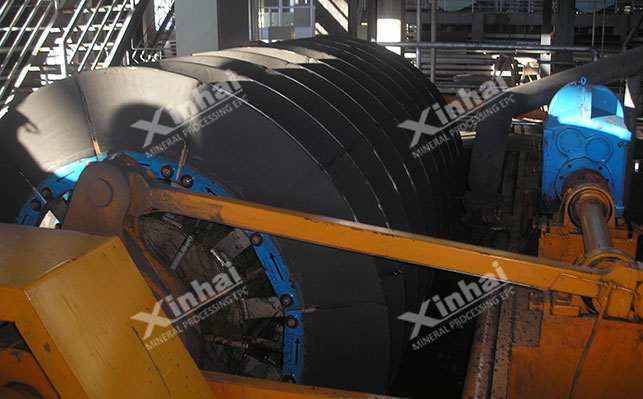
15311826613
Click to add WeChatHematite with high phosphorus content is mostly oolitic hematite, which has fine grain size, iron minerals and gangue minerals forming oolitic granules. The magnetism is relatively weak, the particle size distribution is uneven, and the phosphorus content is relatively high. High, it is easy to muddy during the grinding process, and it is difficult to sort. Currently, the commonly used beneficiation processes for oolitic hematite with high phosphorus content include: Wet magnetic separation process, Single flotation process, Selective flocculation flotation process< /strong>And various combined processes derived on this basis, including Strong magnetic separation + reverse flotation, Selective flocculation followed by flotation desliming + reverse flotation And processes such as reduction roasting + magnetic separation + flotation.
The magnetic separation process mainly uses the magnetic difference between hematite and gangue minerals for selection. The specific magnetization coefficient The greater the difference, the greater the magnetic difference between minerals. Qualified hematite is obtained through a wet strong magnetic separator to remove phosphorus impurities.

The single flotation method is mainly reverse flotation. During the flotation process, chemicals, stirring, aeration and other operations are used to make the gangue minerals adhere to the bubbles and be scraped out with the bubbles. , the iron minerals remain in the tank.
Selective agglomeration flotation uses the property differences between mineral particles to selectively agglomerate useful minerals. The iron minerals are then separated from the phosphorus by reverse flotation. This method has universal applicability, is relatively simple to operate, has low cost and is easy to be applied in industrial production.

The strong magnetic separation-reverse flotation process is to first conduct magnetic separation on the raw ore, and then conduct reverse flotation and dephosphorization on the magnetic separation concentrate. Strong magnetic separation can discard a large amount of waste, which improves the selection grade for reverse flotation. It also has a good desliming effect and creates good selection conditions for reverse flotation. Among them, strong magnetic separation adopts a process of rough selection and sweep selection, and uses SLon high gradient magnetic separator to carry out strong magnetic separation under the condition of grinding fineness of 70% - 0.074mm. Reverse flotation is to carry out reverse flotation of magnetically separated coarse concentrate, using sodium carbonate as modulator, water glass as dispersant, soluble starch as inhibitor of iron minerals, and sodium oleate as gangue mineral (including phosphate-containing minerals). Stone) collector to complete the flotation of iron ore concentrate.

Under the grinding conditions where the raw ore accounts for 70% at -0.74mm, after a rough After one sweep of magnetic separation, the magnetic separation concentrate undergoes a coarse, sweep and fine reverse flotation operation to obtain an iron concentrate with an iron grade of 54.70%, a recovery rate of 79.44%, and a phosphorus content of only 0.17%.
This process uses sodium carbonate to make slurry and water glass as the dispersant , soluble starch is used as a flocculant (and an inhibitor of iron minerals) to selectively flocculate the slurry, and then use No. 2 oil for flotation and desliming. After desliming, the slurry is reverse flotated to obtain iron concentrate. This process can significantly reduce the dosage of flotation reagents such as soluble starch and sodium oleate, greatly reducing the cost of flotation reagents. At the same time, selective flocculation and flotation desliming does not require re-slurrying, making the process smoother.

The reduction roasting + magnetic separation + flotation process is an improvement on the "magnetization roasting-weak magnetic separation" process. It is first heated to a certain temperature by roasting to convert it into iron minerals with strong magnetism. Then grinding-magnetic separation and dephosphorization are carried out. Using this process to treat high-phosphorus oolitic hematite can obtain iron concentrates with higher iron grades and lower phosphorus content, but sometimes Al2O< appears in the iron concentrates. sub>3Exceeding standards.
The above are several common methods for removing phosphorus and beneficiating iron from oolitic hematite with high phosphorus content. In actual beneficiation, due to the different phosphorus content of hematite and the different properties of other impurity minerals, Each is different, so when choosing a process, you should first conduct an ore dressing test analysis. Through the test and analysis results, you can design a suitable hematite beneficiation process and customize a hematite beneficiation process that meets the actual situationHematite beneficiation equipment.